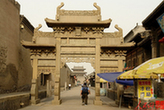Brief Introduction
The largest existing complex of ancient sacrificial buildings in China; masterpiece of China's royal sacrificial buildings complex and one of the best symbolic illustrations of Chinese cosmology.
Located in the southern part of Beijing, the Temple of Heaven (Tiantan) has been one of the most sacred places for the whole country for more than five centuries. It served as a complex of sacrificial buildings for the Ming and Qing emperors, and is the largest one in Beijing among several royal altars to Heaven, Earth, the Sun, the Moon and other deities or symbolic forces of Nature.
Cultural Heritage
The Temple of Heaven was built in 1420 during the reign of Emperor Yongle of the Ming Dynasty (1368-1644), originally as an altar for the worship of both Heaven and Earth. It began to serve as the exclusive imperial altar for Heaven and the Harvest since the worship of Heaven and Earth was divided in 1530, and a new Altar of Earth was built in the northern part of the capital.
In the overall layout and individual designs of its buildings, the Temple of Heaven symbolizes the relationship between Earth and Heaven which stands at the heart of Chinese cosmogony, and also the special role played by the emperors within that relationship.
Surrounded by an outer wall of 5 km, it covers an area of 273 ha, thrice the size of the Forbidden City. It is divided into the Inner Temple (Neitan) and the Outer Temple (Waitan) by a double wall.
The main buildings of the Inner Temple are on a north-south axis, including the Circular Mound Altar (Huanqiutan) in the south and the Altar of Prayer for Good Harvests (Qigutan) in the north. The two altars are connected by a brick and stone walkway named Shendao (Sacred Road), an allusion to the long road to the imperial court. The Outer Temple consists mainly of age-old pinewoods, cypresses and the Department of Sacred Music (Shenyueshu), of which only half remains.
Architecture
In architecture the entire design is symbolic. The southern part of the Inner Temple is square, while the northern part is semi-circular, a pattern representing the ancient belief that Heaven is round and Earth square. The northern wall was built higher than the southern wall, illustrating the notion of Heaven surpassing Earth. Compared to the imposing complexity and intricacy of royal palaces, the altar area here is simple, setting off the vastness of the sky, and the grandeur of Heaven.





Why not rent a boyfriend, or girlfriend to please parents during the Spring Festival?